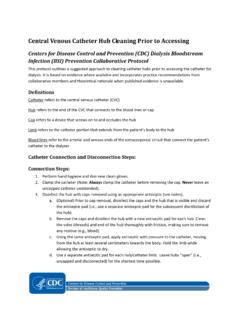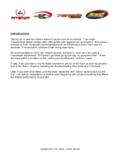Transcription of DIAGNOSTICS: RECOVERY AND RENEWAL - NHS England
1 1 diagnostics : RECOVERY AND RENEWAL OCTOBER 2020 2 FOREWORD The need for radical investment and reform of diagnostic services was recognised at the time the NHS Long Term Plan was published in This report, commissioned by NHS England at that time, alongside a review of adult screening services, was nearing publication before the Covid-19 pandemic struck. However, while the recommendations made pre-pandemic still stand, additional actions will be needed to deliver safe, high quality diagnostic services in an endemic phase of the disease and to support the RECOVERY of diagnostic services. The Covid-19 pandemic has further amplified the need for radical change in the provision of diagnostic services, but has also provided an opportunity for change.
2 Many beneficial changes in relation to diagnostic pathways, such as increased use of virtual consultations and community services, have already been made. These changes must now be embedded. However, much more now needs to be done in the RECOVERY period to establish new pathways to diagnosis, so that both patients and healthcare professionals can be assured that investigations will be done safely. To deliver the increase in diagnostic activity required now and over the coming years, and to provide safe, patient-centred pathways for diagnostics , new service models are needed. Availability of Covid-19 virus testing for patients and healthcare professionals is likely to be critical, especially when community prevalence of the virus is high.
3 Without such testing, patients will have to be considered as Covid-19 uncertain , which will slow throughput in imaging and particularly in endoscopy. The following key actions can be defined: Acute and elective diagnostics should be separated wherever possible to increase efficiency. Acute diagnostic services (for A&E and inpatient care) should be improved so that patients who require CT scanning or ultrasound from A&E can be imaged without delay. Inpatients needing CT or MRI should be able to be scanned on the day of request. Community diagnostic hubs should be established away from acute hospital sites and kept as clear of Covid-19 as possible.
4 Diagnostic services should be organised so that as far as possible patients only have to attend once and, where appropriate, they should be tested for Covid-19 before diagnostic tests are undertaken. Community phlebotomy services should be improved, so that all patients can have blood samples taken close to their homes, at least six days a week, without needing to come to acute hospitals. These new services will require major investment in facilities, equipment and workforce, alongside replacement of obsolete equipment. Training of additional highly skilled staff will take time but should start as soon as possible. International recruitment should be prioritised 1 NHS England .
5 2019. The NHS Long Term Plan 3 when possible but national workforce solutions will also be critical. Alongside this, skill-mix initiatives involving more apprenticeships and assistant practitioners, and using qualified staff at the top of their licence will be essential, as will learning lessons from staff flexibility and roles undertaken during the Covid-19 pandemic. The radical changes recommended in this report will only become a reality if there is sufficient clinical and managerial leadership at national, regional and local levels. Full establishment of networks for imaging, pathology, endoscopy and cardiorespiratory diagnostics will be the driver for change at a local level, alongside those for genomics.
6 At national level, data collections should be improved, commissioning arrangements to drive improvements in diagnostics should be considered and progress on implementation must be closely monitored and evaluated. Implementation of the recommendations of this report will help drive improved outcomes in cancer, stroke, heart disease, respiratory diseases and other conditions in line with the NHS Long Term Plan commitments. Major efficiency gains will also be delivered through bulk buying of imaging equipment; reduced installation costs in non-acute sites; avoidance of duplication of imaging between hospitals; reductions in outsourcing of image acquisition and reporting; efficiencies of patient throughput; skill-mix initiatives; and significant reduction in acute admissions and lengths of stay.
7 Development of this report has been critically dependent on extensive discussions with experts in a wide range of relevant fields. These have included leaders of Royal Colleges and professional societies; national specialist advisors; leads of each of the diagnostic disciplines and national clinical directors in the specialties that are major users of diagnostics ; charities and academics; Get It Right First Time (GIRFT) leads; senior managers in the diagnostics industry and independent sector providers. I would like to thank everybody involved for their contributions. I am extremely grateful for input from colleagues within NHS England and NHS Improvement and Health Education England , and in particular to Sheila Dixon and Ashley Summerfield for their analysis, and to Sally Chapman and Daniel Gosling for their invaluable assistance with the development and drafting of the report.
8 Professor Sir Mike Richards CBE Chair Independent Review of Diagnostic Services for NHS England 4 CONTENTS 2 1. SUMMARY AND RECOMMENDATIONS .. 7 7 Recommendations .. 8 2. THE CASE FOR CHANGE .. 12 Rising demand for diagnostics .. 12 Growth in diagnostics activity .. 12 Reaching a tipping 13 International comparisons .. 14 The impact of covid-19 on diagnostics .. 15 3. NEW SERVICE DELIVERY MODELS FOR RECOVERY AND THE FUTURE .. 18 Separation of acute and elective diagnostics .. 19 Community diagnostic hubs .. 20 New pathways to di agnosis .. 23 Community phlebotomy services .. 24 New diagnostic technologies .. 24 4. EQUIPMENT AND 27 Imaging equipment and facilities.
9 27 Endoscopy equipment and facilities .. 29 Cardiorespiratory diagnostics equipment and f acilities .. 29 Pathology and genomics equipment and facilities .. 30 5. WORKFORCE .. 31 The imaging 31 The endoscopy workforce .. 33 The cardiorespiratory diagnostics workforce .. 34 The pathology workforce .. 35 The genomics workforce .. 36 Changing the shape of the diagnostics workforce .. 36 6. DIGITISATION AND CONNEC TIVITY .. 38 7. DELIVERING THE CHANGE .. 40 Clinical and managerial leadership .. 40 Diagnostic 40 Commissioning for diagnostics .. 41 5 Data and information for monitoring of progress .. 42 43 APPENDIX 1: THE CLINICAL CASE FOR 45 1.
10 Cancer .. 45 2. Cardiac and respiratory diseases .. 46 3. Stroke and transient ischaemic attack .. 49 4. Musculoskeletal conditions .. 50 5. Maternity and gynaecology .. 51 6. Children s services .. 51 7. Ophthalmology .. 51 8. Urology .. 52 9. Liver 53 APPENDIX 2: 54 APPENDIX 3: ENDOSCOPY .. 58 APPENDIX 4: C ARDIORESPIRATORY diagnostics .. 63 APPENDIX 5: PATHOLOGY .. 65 APPENDIX 6: GENOMICS .. 68 APPENDIX 7: GUIDANC E FOR COMMUNITY diagnostics hubs .. 71 APPENDIX 8: POINT OF CARE TESTING .. 80 APPENDIX 9: ARTIFICIAL INTELLIGENCE .. 84 Tables Table 1: Growth in hospital activity 2014/15 to 2018/19 Table 2: Potential volumes of elective imaging activity Table 3: Growth in imaging activity 2014/15 to 2018/19 Table 4: Additional imaging workforce requirements Table : Estimated requirement for imaging equipment over five years Table : Estimated requirement for additional imaging workforce over five years Figures Figure 1: The number of patients waiting 6+ weeks at month end for a diagnostic test Figure 2: CT scanners per 10,000 population: international comparisons (2017) Figure 3: MRI scanners per 10,000 population: international comparisons (2017) Figure 4.

















